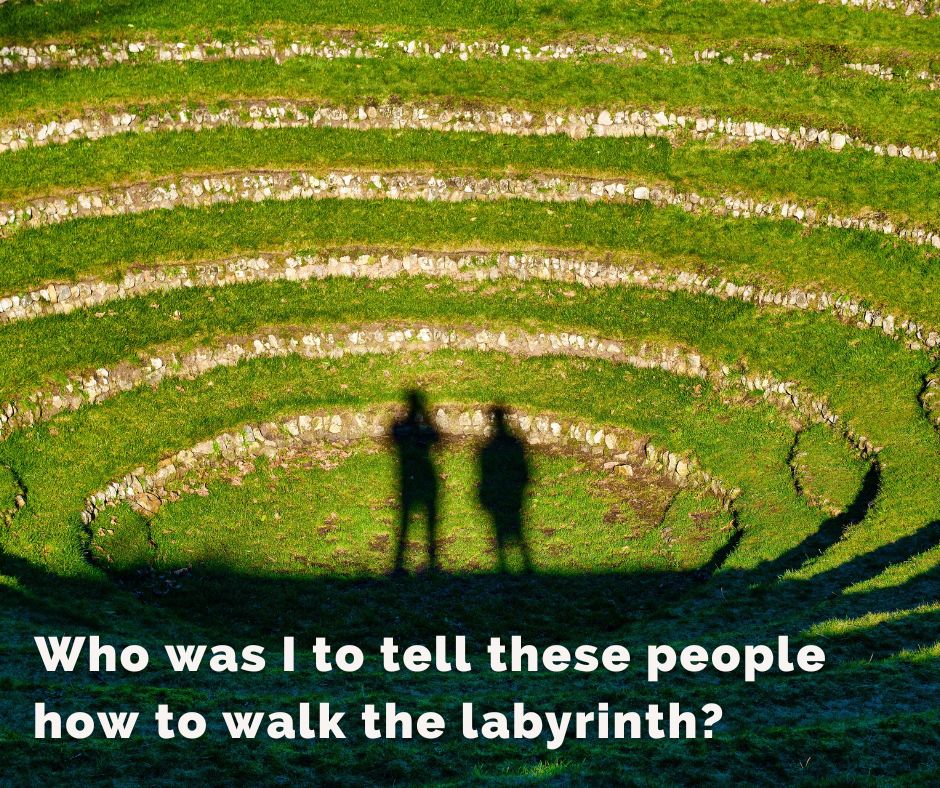Labyrinth Lessons

No, no—that’s not how you do it.
That’s what I was thinking as the group began to walk the labyrinth. They were here for one of the retreats that Pam and I host here at Copper House. The leader asked if the small group of six could use the labyrinth for one of their sessions, so I led them out to the prayer circle we had just finished building and stayed to watch.
The leader divided them into groups of two and asked them to walk the labyrinth together. The one chosen to walk would close her eyes and be guided by her partner standing outside the circle.
That’s not how you walk a labyrinth, I wanted to say. It’s not a corporate team-building event like a blindfolded obstacle course. It’s a walking meditation!
Then I watched as one person took halting steps, bumped into the stone borders, froze, would not move without a word from her coach. I watched how the one outside the circle offered directional cues, some that worked and some that didn’t. Left. Right. No—30 degrees right. And the one that moved me most: Come to the sound of my voice.
Who was I to tell these people how to walk the labyrinth?
If the twisting circuits of a labyrinth are meant to portray the decidedly non-linear path of our lives, the sightless walker added yet another layer of verisimilitude: the path is twisted and we mostly walk blind. “For we walk by faith, not by sight” (2 Cor. 5:7). How many times in my life had I been utterly lost, not only without direction but without sight, without bearings, without hope?
And if the gift of a labyrinth is to allow a pilgrim to trust the direction of a power beyond us, then having a coach guiding you home is just perfect. When people tell stories of God intervening in their lives, offering direction and hope, it almost always involves another person, someone who mediates the divine presence for us. So why was I so sure that the right way to walk a labyrinth is alone?
“We walk by faith, not by sight.” Yes, but as you point out, walking by faith doesn’t mean walking alone.
Love your vulnerability–again in this post, so often in your posts–Who was I to tell these people how to do it?
Beautifully stated
Nailed it again, David. Perfect.
I’m going to re-read this again and again, because I am very uncomfortable when I am called to walk by faith and not by sight. You embodied that scripture when you were uncomfortable, seeing how the labyrinth you had created was going to be used. God shows us so much more than we can see on our own if we will only tolerate the discomfort and have faith. Your example will help me too, as I struggle to choose faith over discomfort.
Love how you said that, Ann—that God shows us so much more than we thought possible (or “correct”!) if we can stand the brief period of discomfort that always follows a change we weren’t ready for.
Again, heartfelt thanks for this post. I am walking my own labyrinth: a dissolved and abusive marriage of almost 25 years. The acceptance of hurting made a gradual and now brave appearance. It has taken me threats of death to ‘awaken’. The loss of a dream and the hope of reconciliation evaporated. With the death of my daughter, his stepchild, I began to understand that God did not choose to have His followers be injured. Jesus paid for that. I want no retribution. Jesus paid for that. I want peace for what years here are allotted to me. Jesus has offered that. Please pray that I may accept my Savior’s plan and His great love. And please keep everyone uplifted with your intuitive insights. Blessings.
Thank you for sharing your story, Donna—what you have endured is monumental, and yet you continue to trust that God can lead you through it all to a place of loving acceptance. May the Lord grant you the grace and courage to keep walking the path.
It’s interesting. Most of us know better than to correct a child who plays with a toy in a way it wasn’t particular intended to be played with. I’ll remember your words when I’m tempted to correct a once-was-a-child playing with God’s sacred toys.
That’s a great analogy